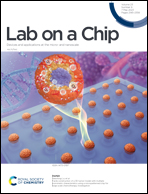Lab-in-a-fiber-based integrated particle separation and counting†
Abstract
An all-fiber integrated device capable of separating and counting particles is presented. A sequence of silica fiber capillaries with various diameters and longitudinal cavities are used to fabricate the component for size-based elasto-inertial passive separation of particles followed by detection in an uninterrupted continuous flow. Experimentally, fluorescent particles of 1 μm and 10 μm sizes are mixed in a visco-elastic fluid and fed into the all-fiber separation component. The particles are sheathed by an elasticity enhancer (PEO – polyethylene oxide) to the side walls. Larger 10 μm particles migrate to the center of the silica capillary due to the combined inertial lift force and elastic force, while the smaller 1 μm particles are unaffected, and exit from a side capillary. A separation efficiency of 100% for the 10 μm and 97% for the 1 μm particles is achieved at a total flow rate of 50 μL min−1. To the best of our knowledge, this is the first time effective inertial-based separation has been demonstrated in circular cross-section microchannels. In the following step, the separated 10 μm particles are routed through another all-fiber component for counting and a counting throughput of ∼1400 particles per min is demonstrated. We anticipate the ability to combine high throughput separation and precise 3D control of particle position for ease of counting will aid in the development of advanced microflow cytometers capable of particle separation and quantification for various biomedical applications.



 Please wait while we load your content...
Please wait while we load your content...